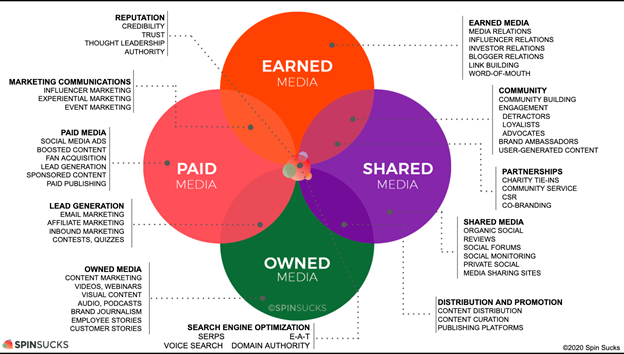
A version of this post previously appeared on the Public Relations Professionals of India blog.
In the United States and increasingly around the world, the most commonly accepted definition of owned content comes from the PESO model developed by Gini Dietrich, founder of the top-five PR blog, Spin Sucks (see below).
Within the universe of owned media, one of the fast-growing categories is brand journalism.
As the president and chief storyteller at WordWrite, a public relations firm that connects providers of complex services with C Suite leaders of middle-market companies, storytelling is at the heart of everything we do. And brand journalism is a premier means of storytelling.
I have love and respect for journalism — I spent two decades covering everything from murders to the White House. I wrote more than 10,000 stories and edited another 10,000 before entering the agency field, first at Ketchum Public Relations, and for the last 20 years, at WordWrite.
Brand journalism enables our firm and our clients to make the most of our team’s considerable journalism experience to share stories that otherwise wouldn’t be seen, given the challenges in journalism today.
We believe in brand journalism so much that we added Dan Stefano, a talented editor and writer, to our team a few years ago with the title of brand journalist. Along with me and vice president and partner Jeremy Church, Dan is the latest in a line of WordWriters who’ve cut their storytelling teeth in the crucible of journalism.
And with Dan’s guidance, we’ve made our brand journalism a multimedia foray, with an ezine and podcast (more on those in a bit).
So is brand journalism for you, or is it just a fad? Let’s dig in — you decide!
Defining it
Brand journalism is a unique species, or as Andy Bull, author of the book “Brand Journalism” said, it’s “a hybrid form of traditional journalism, marketing and public relations. It has emerged as a reaction to what Tom Foremski, a former Financial Times journalist now reporting on Silicon Valley, has dubbed EC=MC: every company is a media company. Brand journalism is a response to the fact that any organization can now use journalistic techniques to tell its story direct to the public.”
Let’s be clear: Brand journalism is not a replacement for traditional journalism. As Daniel Newman, CEO of Broadsuite Media Group, put it in a Forbes article, “Brand journalism focuses on building stories and other informational content that highlights value from a different point of view. Companies that embrace brand journalism use interviews and article-based websites that provide journalistic information to support a product’s offerings.”
Among the leaders in brand journalism are companies as large and well-known as Coca-Cola, Intel and Patagonia.
Why it’s needed
Financial pressures on journalism continue to shrink editorial voices that have traditionally provided earned media to companies and brands. In the United States, more than 2,000 newspapers and tens of thousands of journalism jobs have disappeared in the last decade.
Aside from the societal impact of a shrinking profession committed to truth-telling, the silencing of editorial voices means brands and companies with valuable stories have fewer opportunities to share those stories. To address this, many companies and brands have become their own publishers – brand journalists.
How it works
Successful brand journalism provides educational and informative content that, while clearly coming from a sponsor, is transparently presented.
The best brand journalism publishers apply a journalistic formula for success by:
- Hiring the “write people” (frequently journalists, who know how to share stories)
- Developing a consistent structure (regular publishing, themes for issues, etc.)
- Committing the people and other resources to do it right
A case study: The Pittsburgh 100
At WordWrite, we believe in brand journalism because we do it ourselves, publishing The Pittsburgh 100.
Our 100 is part of an international network of 28 ezines affiliated with The 100 Companies. Chris Schroder, founder of The 100 Companies and former journalist, developed a successful community-based model that began with regional publications. Today it includes publications with deep industry focus, including The Engineering 100 and The Travel 100.
Done well, brand journalism provides content that shares an organization’s story in a way that educates, and informs – and doesn’t sell.
That doesn’t mean brand journalism doesn’t drive results; it means that those results come from two-way engagement with audiences. The audiences can engage as deeply as they like – consuming, sharing content on social media and clicking on calls to action that deepen the relationship with the sponsors.
In the case of The 100 Companies publications, this also means ensuring that whitelisted domains send the ezines, that there’s tracking and measurement of results, and that the content produces great search engine optimization and marketing.
The Pittsburgh 100 has grown to more than 42,000 subscribers in just three years, enjoys high open rates and delivers great results for clients. For example, one law firm that wrote expert articles in each issue counted The Pittsburgh 100 as the number two source of traffic to its website behind LinkedIn.
In addition to the Pittsburgh 100 ezine and website, we have also added a podcast, The P100, which we describe as the audio companion to the Pittsburgh 100. Or as we put in each episode, we do the podcast, because sometimes, 100 words aren’t enough. The podcast allows us to do long-form interviews with interesting leaders and personalities, not all of whom appear in stories in the Pittsburgh 100 itself. It’s another dimension to brand journalism and the evolving role of publisher that so many marketers are adopting.
So among all the flavors of owned content available to your organization, is brand journalism right for you? I like the way Stephanie Losee, head of content for VISA, put it in a Mashable article a few years ago:
“The reason to launch your own,” she said, “is not to crow about yourselves. You can try it if you like, but I promise you the audience will vote with their feet. It’s like any interaction — do you prefer to spend your time with people who go on and on about themselves, or whose conversation adds something to your life and addresses your needs in some way?”
Learn more about brand journalism:
- Ragan brand journalism guide
- Alabama Seafood
- Denver Water (SlideShare)
- What content marketing can learn from journalism
- The Pittsburgh 100
